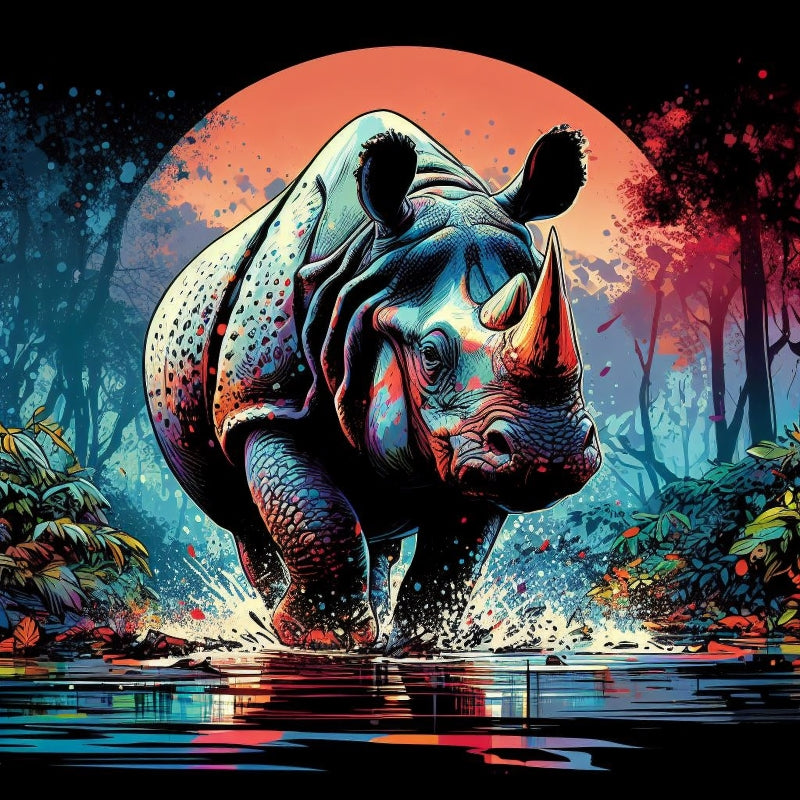
Where Rhinos Are Found in the World
Share
Rhinoceroses, often referred to as rhinos, are among the largest land mammals on Earth and are known for their distinctive horns and thick skin. These magnificent creatures have captured human imagination and cultural significance across various societies. However, rhino populations have drastically declined due to poaching and habitat loss. This blog post explores where rhinos are found globally, detailing their habitats, conservation status, and the efforts being made to protect them.
- Rhino Species Overview
There are five extant species of rhinos, divided into two main categories: African rhinos and Asian rhinos. Each species has distinct habitats and ranges:
- African Rhinos:
- White Rhino (Ceratotherium simum): The largest of the rhino species, white rhinos are further divided into two subspecies: the Southern white rhino and the critically endangered Northern white rhino.
- Black Rhino (Diceros bicornis): Smaller than white rhinos, black rhinos have a hooked upper lip adapted for browsing on bushes and trees.
- Asian Rhinos:
- Greater One-Horned Rhino (Rhinoceros unicornis): Also known as the Indian rhinoceros, this species is primarily found in India and Nepal.
- Javan Rhino (Rhinoceros sondaicus): This critically endangered species is found only in Ujung Kulon National Park in Java, Indonesia.
- Sumatran Rhino (Dicerorhinus sumatrensis): The smallest living rhinoceros species, Sumatran rhinos inhabit the forests of Sumatra and Borneo.
- Habitat Distribution
African Rhinos
- White Rhinos:
- The majority of Southern white rhinos are found in South Africa, with significant populations also in Namibia, Zimbabwe, and Kenya. These regions provide vast savannas that support their grazing habits. The Northern white rhino, on the other hand, is nearly extinct in the wild, with only two known individuals remaining under constant protection in Kenya.
- Black Rhinos:
- Black rhinos inhabit a wider range of environments compared to white rhinos. They can be found in various habitats including savannas, deserts, and scrublands across countries like South Africa, Namibia, Zimbabwe, Kenya, and Tanzania. Their adaptability allows them to thrive in diverse ecosystems.
Asian Rhinos
- Greater One-Horned Rhino:
- Greater one-horned rhinos primarily inhabit the grasslands and riverine forests of northeastern India and southern Nepal. Key locations include Kaziranga National Park and Manas National Park in Assam, as well as Chitwan National Park in Nepal. Kaziranga is particularly notable for its successful conservation efforts; it is home to approximately two-thirds of the world's greater one-horned rhinoceros population.
- Javan Rhino:
- The Javan rhinoceros is critically endangered, with its entire population confined to Ujung Kulon National Park in Java, Indonesia. This park provides a protected habitat where conservation efforts are focused on preventing poaching and habitat destruction.
- Sumatran Rhino:
- Sumatran rhinos are also critically endangered and primarily found in fragmented rainforests on the islands of Sumatra and Borneo. Their populations are scattered across several protected areas such as Bukit Barisan Selatan National Park in Sumatra and the forests of Borneo. Conservationists face significant challenges due to habitat loss from palm oil plantations and illegal poaching.
- Conservation Status
All five species of rhinoceroses face threats from poaching for their horns—highly valued in traditional medicine markets—and habitat loss due to agricultural expansion and urban development. The International Union for Conservation of Nature (IUCN) classifies three species as critically endangered:
- Black Rhino: Once numbering over 100,000 individuals in the early 20th century, black rhino populations have decreased to around 5,500 today due to intense poaching pressures.
- Javan Rhino: With fewer than 80 individuals remaining in the wild, Javan rhinos are considered one of the most endangered large mammals on Earth.
- Sumatran Rhino: Estimates suggest that there are fewer than 80 Sumatran rhinos, making them critically endangered as well.
Conversely, greater one-horned rhinos have seen a resurgence thanks to effective conservation measures; their population has increased from fewer than 200 individuals a century ago to over 4,000 today, classified as vulnerable.
- Conservation Efforts
The plight of rhinoceroses has spurred numerous conservation initiatives aimed at protecting these magnificent animals:
Project Tiger
In India, Project Tiger was launched in 1973 to protect tigers but also indirectly benefited other wildlife species, including greater one-horned rhinos through habitat preservation efforts.
Anti-Poaching Initiatives
Many countries have implemented strict anti-poaching measures that include increased patrols within national parks and wildlife reserves. For example:
- In Kaziranga National Park, armed guards patrol regularly to deter poachers while community engagement programs educate locals about the importance of conservation.
- In South Africa, advanced technology such as drones and camera traps is utilized to monitor wildlife movements and detect illegal activities.
Habitat Restoration
Efforts are underway globally to restore habitats critical for rhinoceroses’ populations:
- In Indonesia’s Ujung Kulon National Park, initiatives focus on maintaining natural ecosystems while preventing human encroachment that threatens Javan rhinoceros habitats.
- In Borneo’s forests where Sumatran rhinos reside, organizations work with local communities to promote sustainable land-use practices that protect remaining forest areas from deforestation.
- Ecological Importance
Rhinoceroses play a vital role in their ecosystems:
- As herbivores that graze on grasses or browse on shrubs and trees, they help maintain vegetation balance within their habitats. Their feeding habits can create open areas that benefit other herbivores by promoting diverse plant growth.
- Additionally, when they consume fruits or seeds from plants they eat—these seeds are dispersed through their dung—contributing to plant regeneration within their ecosystems.
Conclusion
Rhinoceroses are remarkable creatures that embody both ecological significance and cultural heritage across different regions of the world. From African savannas teeming with white and black rhinos to Asian forests housing greater one-horned rhinos—their presence enriches biodiversity while highlighting our responsibility towards wildlife conservation.
Understanding where rhinos are found helps raise awareness about their ecological needs while emphasizing the importance of preserving their habitats for future generations. Through collaborative efforts aimed at protecting these iconic animals from threats like habitat loss or poaching—we can ensure that future generations will continue marveling at these incredible beings roaming freely across our landscapes! By fostering coexistence strategies that benefit both humans and wildlife alike—we can create a sustainable future where rhinoceroses thrive alongside us!
Citations:
[1] https://rhinorecoveryfund.org/distribution-status/
[2] https://wildlifesos.org/conservation-awarness/knowing-the-worlds-rhinos/
[3] https://rhinos.org/about-rhinos/rhino-species/greater-one-horned-rhino/
[4] https://wwf.panda.org/discover/knowledge_hub/endangered_species/rhinoceros/asian_rhinos/
[5] https://en.wikipedia.org/wiki/Rhinoceros